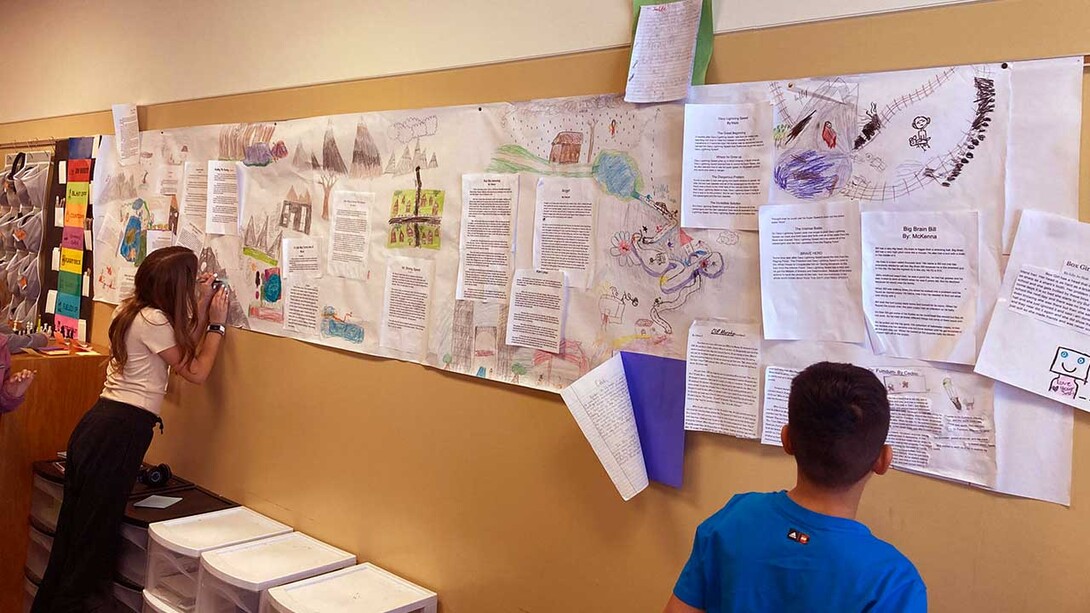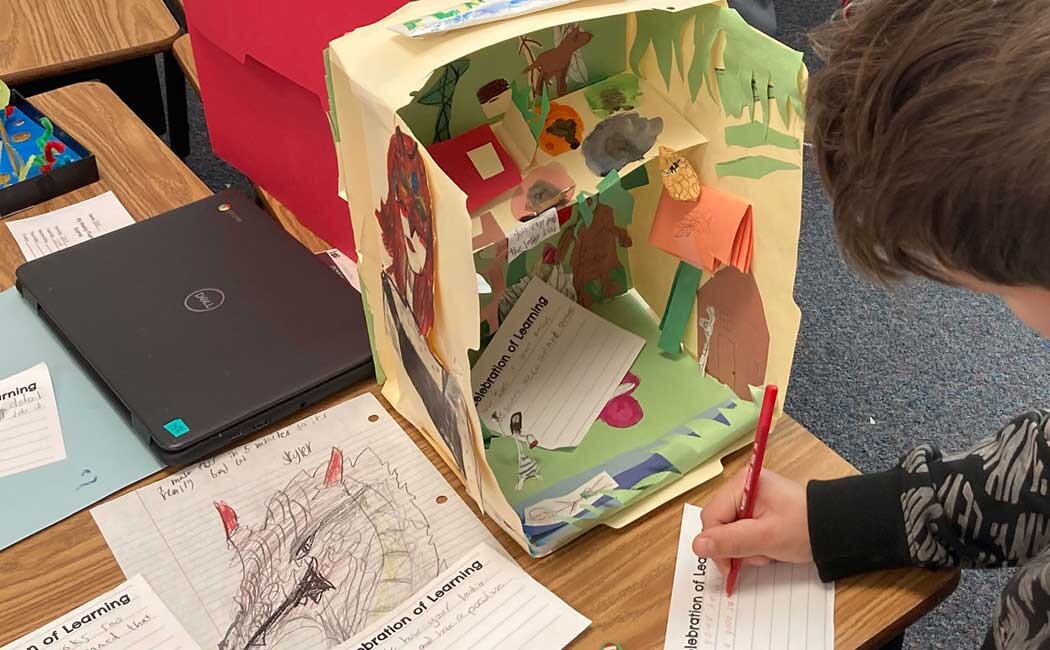
As technology continues to rapidly evolve, a group of Nebraska researchers is collaborating with the state’s K-12 educators, artists and administrators to imagine the future of education.
The Teaching with Arts and Emerging Media (Art TEAMS) project is under way in classrooms throughout Nebraska. The five-year pilot project is designed to promote teaching innovation through arts and emerging media in Nebraska public schools.
The project is a collaboration between the Hixson-Lied College of Fine and Performing Arts and a research team that includes Guy Trainin, professor of education in the Department of Teaching, Learning and Teacher Education; Kimberly D’Adamo, teacher educator; Lorinda Rice, Lincoln Public Schools art curriculum specialist; and HyeonJin Yoon, MAP Academy research assistant professor.
Also involved were Laura Huntimer, who oversees and develops school, teacher and digital educational programs at Joslyn Art Museum in Omaha, and the Carson Center for Emerging Media Arts.
After the first year of implementing ideas learned in the project, participating teachers and their students are excited about where the possibilities will lead.
Funded by a $1.9 million grant from the U.S. Department of Education and housed at the Nebraska Center for Research in Children, Youth, Families and Schools, Art TEAMS is designed to establish a professional development curriculum for 40 Nebraska public school teachers to integrate arts and emerging media into their curricula.
Emerging media is loosely defined as communication using digital technology, usually with interactive components. Examples include virtual reality, social media apps, video creation technology and artificial intelligence applications such as ChatGPT and Dall-E.
In summer 2022, the first cohort of 16 teachers recruited from Nebraska public schools began an intensive, two-week curriculum at the University of Nebraska–Lincoln. Teachers were teamed in pairs — for example, a science teacher and an art teacher — to encourage them to think about how their work can intersect.

Their professional development continued throughout the 2022-23 academic year, as they began using what they had learned with students in their own classrooms. The teachers attended additional professional learning workshops during summer 2023, and their development will continue through the 2023-24 academic year.
During the summer sessions, local artists shared their expertise with teachers, including Jordan Charlton, a doctoral student and poet at the University of Nebraska-Lincoln; Dana Fritz, Hixson-Lied professor of art; Erica Larsen, Johnny Carson Center for Emerging Media Arts; and David Manzanares, an Omaha-based artist.
Teachers also visited several art-centered spaces, including Lincoln’s Lux Center for the Arts, the Tugboat Gallery, Great Plains Gallery and the Nebraska History Museum; Omaha’s Union for Contemporary Art, The Artist Co-Op Gallery and Bemis Center for Contemporary Arts; and NU’s International Quilt Museum.
In spring 2024, the second cohort of teachers will be recruited. Their professional development will begin with workshops in summer 2024, following the same two-week schedule of initial instruction and coaching, and will start applying elements of Art TEAMS to their classrooms during the 2024-25 academic year.
Teachers who complete the two-year curriculum earn 18 graduate-level credits.
Ryan Margheim, a second-grade teacher at Omaha’s Nelson Mandela Elementary School, is a member of the first cohort who began using elements of Art TEAMS in his classroom during the 2022-23 academic year. His students, he said, have particularly enjoyed the creative art journals and the thinking wall — two concepts Margheim adopted from the program.
The creative art journals were filled with student ideas developed during Friday brainstorming sessions. Every week, Margheim’s students would self-select three to five ideas they wanted to add into their individual journals — something they could either write or draw. As time went on, the journals overflowed with ideas.
“We talked about what we learned, why we learned it and how we could put these things into practice,” Margheim said. “My kids would start in their journals and work out ideas, then add those ideas to the ‘thinking wall.’ They became these communal art pieces. For my kids, that was a real game-changer.”
The idea for the thinking wall — a long piece of paper on the hallway wall outside Margheim’s classroom — sprang from the Reggio Emilia approach to learning: An educational philosophy focused on teaching children how to use symbolic languages — painting, sculpting and drama, for example — in everyday life.
Throughout the school year, his students explained the thinking wall to other students, teachers, administrators and anyone else who asked, eagerly sharing details about how every little piece was part of a bigger concept.
“It became a public map of learning,” Margheim said.

Amy Spilker, second-grade teacher at Lincoln’s Holmes Elementary, has also used thinking walls for her students during the past academic year.
“They provide a great way to organize your students’ ideas, make learning visible, generate curiosity and increase engagement,” she said. “Students loved working on them and seeing what they looked like when they were completed.”
Spilker’s students used a journal in place of worksheets typically used for reading comprehension. The open-journal format was kept in a notebook in which students could make annotations or drawings of things that occurred to them while they were reading or discussing a story as a class. There was also space for them to write questions they had and ideas that occurred to them during discussions.
Students also used journals to record research with notes and drawings, which were then used to make sketches and plans of artwork they were creating.
Exhibitions of learning also were a hit with Spilker’s students.
“The students loved sharing their completed projects and journals with other students,” she said. “They love giving and receiving positive feedback.”
One of the things Margheim enjoys most about the concepts he has picked up through Art TEAMS is how much more student-directed his classroom has become.
“This project has given me the tools to create an environment that allows students to make their own choices and follow pathways they want to follow, but also keeps things manageable for me as a teacher — to steer things in the right direction,” he said.
Spilker noted that her students were excited to collaborate and share, often bringing items form home that related to class research projects.
“I think the most exciting part about this project is the engagement students have, and the opportunity they have to feel ownership,” Spilker said. “It feels like we’re putting more choice and ownership back in the hands of our learners.”
As the professional learning model matures, Trainin’s goal is to share it with a broader group of teachers across Nebraska and, eventually, throughout the U.S.
“Teachers think about how to serve their students, and school districts look a year or two ahead,” Trainin said. “But universities can dream about potential futures in a decade or two, and what teaching and learning should look like. We have the ability to go into the classrooms, see the intersections, come out and think and rethink, then craft ideas of what universities and should develop in the future.”
Learn more about this project in the CYFS Research Network, and check out the Art TEAMS YouTube channel.







